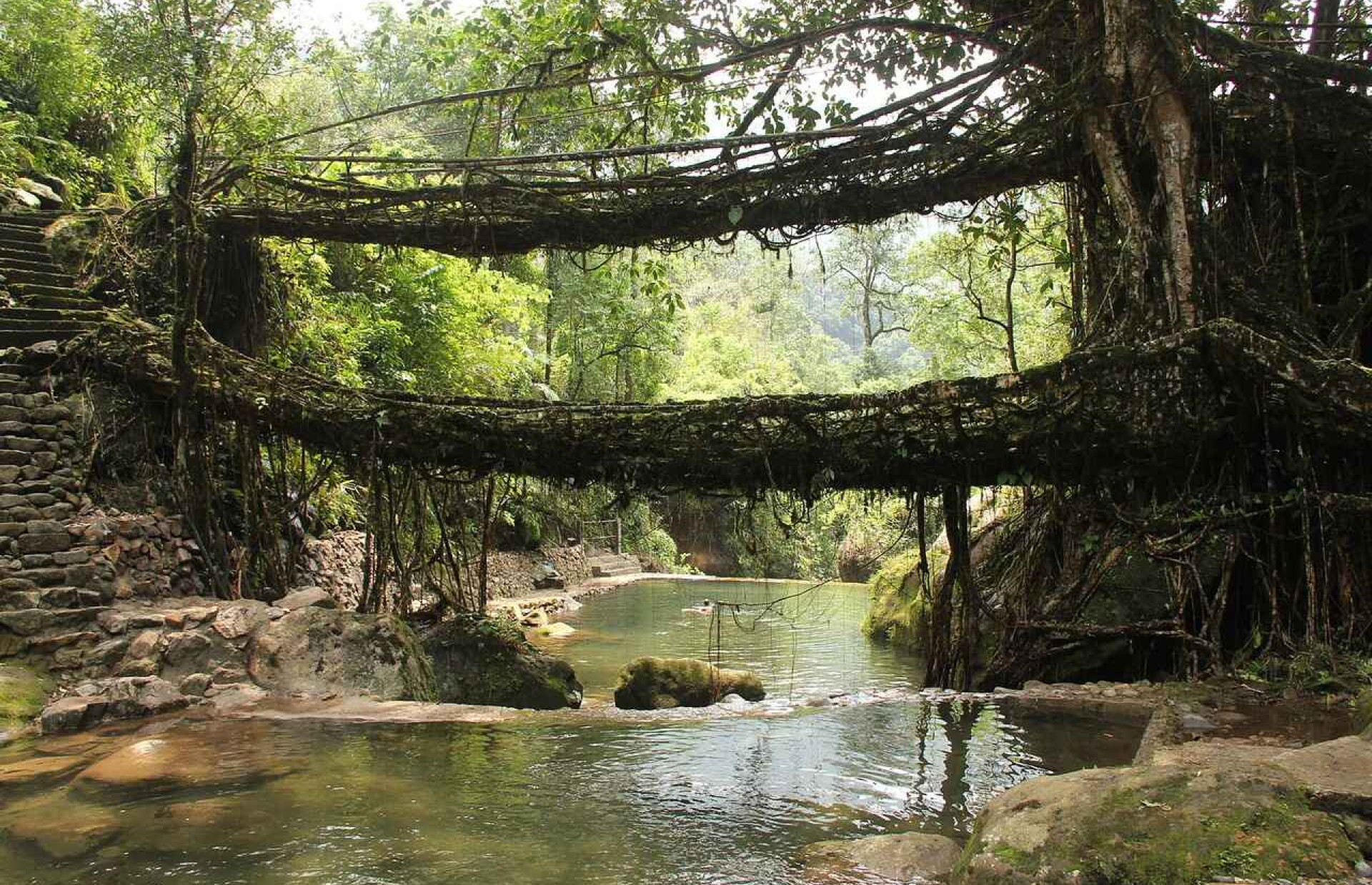Living Root Bridges in Meghalaya
Living Root Bridges in Meghalaya-Centuries-old bridges grown from tangled roots:
IN THE DEPTHS OF NORTH EASTERN India, within sight of the India-Bangladesh border, in one of the wettest places on earth, bridges aren’t built—they’re grown.
There are bridges around the world that are known to be human’s finest creations! But the natural marvel of Living Root Bridges in Meghalaya is mind-blowing. These wonderful structures have meticulously grown over a period of time and are among the biggest attractions in Meghalaya.
The ever evolving Meghalaya bridges are made up of tangled thick roots that provide formidability to the structure and make it good enough to hold 50 or more people in one go. They are grown by trained Khasi and Jaintia tribes who have mastered the art of growing root bridges across raised banks of streams running through the dense woods of Meghalaya. The southern Khasi and Jaintia hills are humid and warm, crisscrossed by swift-flowing rivers and mountain streams. On the slopes of these hills, a species of Indian rubber tree with an incredibly strong root system thrives and flourishes.
living root bridges — aerial bridges built by weaving and manipulating the roots of the Indian rubber tree — have been serving as connectors for generations in Meghalaya. Spanning between 15 and 250 feet and built over centuries, the bridges, primarily a means to cross streams and rivers, have also become world-famous tourist attractions. Now, new research investigates these structures and proposes to integrate them in modern architecture around the world, and potentially help make cities more environment-friendly.
History behind this Nature’s Marvel:
The whole idea of Meghalaya’s living bridges came into the picture somewhere two centuries ago (180 years precisely) when veterans of Khasi clan living in Meghalaya put rubber tree roots into hollow canes of Areca nut palm that met halfway across the stream. The roots were nurtured and cared properly until they grew enough to reach the opposite bank, get completely entwined with each other, and make themselves capable enough to carry heavy weight. The Ficus elastica produces a series of secondary roots from higher up its trunk and can comfortably perch atop huge boulders along the riverbanks, or even in the middle of the rivers themselves. The Ficus elastica produces a series of secondary roots from higher up its trunk and can comfortably perch atop huge boulders along the riverbanks, or even in the middle of the rivers themselves.
An opportunity & Strategies applied to cross the river:
The War-Khasis and War-Jaintias, two closely related tribes in Meghalaya, noticed this tree and saw in its powerful roots an opportunity to easily cross the area’s many rivers. Now, whenever and wherever the need arises, they simply grow their bridges. In order to make a rubber tree’s roots grow in the right direction—say, over a river—the people of southern Meghalaya have used several different strategies. Sometimes, the roots of the trees are simply pulled, tied, twisted, and encouraged by hand to merge with each other, until, over time, they form the desired architectural structure. Root bridges have also been made by creating scaffolds out of wood and bamboo, and then training the young roots out across these temporary structures, replacing the more perishable elements many times as they rot in the intense monsoon seasons.
.jpeg)
In some places, such as around the village of Nongriat, betel nut trunks, sliced down the middle and hollowed out, are used to create root-guidance systems. The thin, tender roots of the rubber tree, prevented from fanning out by the betel nut trunks, grow straight out. The trunks also have the added advantage of providing the roots with additional nutrients as they decay. When they reach the other side of the river, they’re allowed to take root in the soil. Given enough time a sturdy, living bridge is produced.
Weighing Capacity & Life span of these root bridges:
The root bridges can grow for as long as the organism they are a part of remains healthy, though they can take many years to initially become functional, the length of time being dependent on local conditions such as the health of the tree, the way the bridge is being grown, and the availability of nutrients in the soil that its being grown in. However, once root bridges become established, they’re extraordinarily strong—strong enough that some of them can support the weight of 50 or more people at a time. In fact, because they are alive and still growing, the bridges actually gain strength over time—and some of the ancient root bridges used daily by the people of the villages around Cherrapunji may be well over 500 years old.
The roots bridges of southern Meghalaya come in a huge variety of shapes and sizes. They have been known to grow as long as 170 feet, and soar 80 feet above the streams they cross. Most living root bridges only have a single span, yet several have more than one, arranged as either as two parallel spans, or as two bridges stacked one over the other, such as the famous “Umshiang Double-Decker Root Bridge.”
The practice of creating new living bridges, and of preserving ones already in existence, is over large parts of Southern Meghalaya slowly fading out. In many villages across the region, the root bridges are little more than a memory. However, since they began attracting attention again in around 2004, local dedication to the bridges has, at least in a few places, kept them from being destroyed in favor of steel ones. What’s more, a few new root bridges are currently under construction. In the village of Rangthylliang, an entirely new bridge is being grown using a bamboo and wood scaffold, and at the double-decker site in Nongriat, a new, third span is currently being grown above the other two, and should be ready for use within a decade.
In short,
Some of the interesting facts about these bridges are:
- The Living Root Bridges are made from rubber tree roots also known as Ficus elastica tree.
- Some of the root bridges are over 100 feet long and take 10 to 15 years to attain the perfect shape.
- Once fully grown, these roots last for as long as 500 years. While some of the roots decay because of their continuous association of water, others grow and make up for the decayed, thus providing the required stability to the bridge.
- Of all the Living Root Bridges in Meghalaya, the double-decker root bridge in Cherrapunji and the single-decker root bridge in Shillong are the unique bridges in the world and make for prime attraction in the Northeast.
- Living Root Bridges in Meghalaya are recognized by UNESCO as a World Heritage Sites.
Know Before You Go:
While there are dozens of root bridges, which can be found all throughout the valleys between (very roughly!) the towns of Mawsynram and Dawki, few of these are easily accessible, or have nearby tourist facilities.
Best for the Adventure Seekers and Trekkers:
To visit the bridges in the more remote areas, a local guide is an absolute must!
A number of these bridges can be reached from Cherrapunjee. The "Umshiang Double-Decker Root Bridge" is located in the village of Nongriat. Visitors can walk here from the small village of Tyrna. The village is accessible from Cherrapunjee by shared or private taxi. From the village, 2500 steps must be traversed to reach Nongriat. The walk takes about 1.5 - 2 hours each way. Nongriat offers basic accommodation to visitors, so it's possible to stay overnight for a more relaxed experience.
From Nongriat, short hikes can lead you to several nearby root bridges, include several upstream from the village, a small, nice one, in the village of Mynteng, and several spectacular examples in the village of Nongthymmai.
A large number of living root bridges are known to exist in the jungles around the town of Pynursla. To reach these, many of which are deep in the jungle and require several hours of tough hiking, make sure to find a reliable, local, guide.
Another option for visiting root bridges is the beautiful, remote, village of Kongthong, which has several in the near vicinity. This village is the great base to explore the area from, with several spectacular root bridges within a few hours walk.
There's also the village of Shnongpdeng, in the West Jaintia Hills, near Dawki, which can be used as a great staging area to explore several villages with root bridges.
Recommended are Coding Rim, Padu, and Burma. All of these villages have very little in the way of tourist facilities, so make sure to ask for help planning your visit in Shnongpdeng! Please respect the area's natural surroundings.
Following are some of the popular root bridges of Cherrapunjee:
Umshiang Double Decker Root Bridge: The most popular root bridge, a double-decker living-root bridge, it is 3 km long and begins from Village Tyrna Village. The bridge stands at a height of 2400 feet. Reaching the upper bridge, which is 20 meter long is a tough but a worth -it task. Please take note that one needs to be physically fit to reach the upper bridge.
.jpeg)
Ummunoi Root Bridges: A very popular attraction, this is known to be the oldest living bridge of the region. Place at a height of 1400 feet, this bridge is 74 m long.
Ritymmen Root Bridge: Settled in Nongthymmai village, this bridge is 30 m long. If you start trekking from Village Tyrna, this bride would fall on your way to double-decker living root bridges.
Umkar Root Bridge: Beginning from Village Siej, this is a short bridge. It takes just half an hour to walk to and fro on it. Local floods a few years ago had washed away a portion of bridge that is being re-built by the locals. During the monsoon season, a visit to this bridge is even more exciting as a waterfall gushes along the bridge at that time.
Mawsaw Root Bridge: If you continue walking past Umshiang for around 20 - 30 minutes, you arrive at the Mawsaw Bridge. The natural swimming pool is the star attraction of this bridge.
Location: Living Root Bridges are found in West Jaintia Hills district, East Khasi Hills district, and a few other areas of Meghalaya that are among the places in India that deserve more travelers. However, the best root bridges are concentrated in Cherrapunji and Shillong. Here is how to reach these beautiful destinations. Both these towns are accessible from Guwahati.
How to reach Shillong & Cherrapunji from Guwahati:
Guwahati being a major city in the Northeast India acts as a hub for everyone traveling to the region. One can easily find plenty of commuting options to all the places in the Northeast from Guwahati.
By air: Guwahati airport at a distance of 123 km from Shillong, is well connected with major airports in India. Reserved cabs are mostly preferred by people to come down to Shillong from the airport. Shillong to Cherrapunji is 54 km, which is a 2-hour ride by a local bus or a cab.
By train: Guwahati Railway Station is the nearest railhead to Meghalaya. It is very well connected to other major railway stations across India and commuting to Shillong and other major cities of the Northeast India is quite convenient. The 148 km distance between Guwahati to Cherrapunji can be covered in 4 hours by a taxi or a private/government bus.
By road: Volvo buses and government buses run from Guwahati to Shillong and Cherrapunji run in tandem at regular intervals. The 99 km distance between Guwahati to Shillong is full of exciting views, which is indeed a treat for all the travelers.
What Research says about Living Root Bridges?
Researchers from Germany investigated 77 bridges over three expeditions in the Khasi and Jaintia Hills of Meghalaya during 2015, 2016 and 2017. Taking into account structural properties, history and maintenance, morphology and ecological significance, the study, published in the journal Scientific Reports, suggests that:
- Ficus elastica is conducive to the growth of bridges because of its very nature. “There are three main properties: they are elastic, the roots easily combine and the plants grow in rough, rocky soils,”
- The bridges can be considered a reference point for future botanical architecture projects in urban contexts.
- The findings relating to the traditional techniques of the Khasi people can promote the further development of modern architecture,”
- The researchers believe this extraordinary building technique can help facilitate “better adaptation to the impacts of climate change”.
- There is a great potential to use these techniques to develop new forms of urban green in dense cities.
- By understanding the growth history, we can learn how long the bridge has taken to grow to its current state and from there design future growth or repairs, or growth of other bridges.










